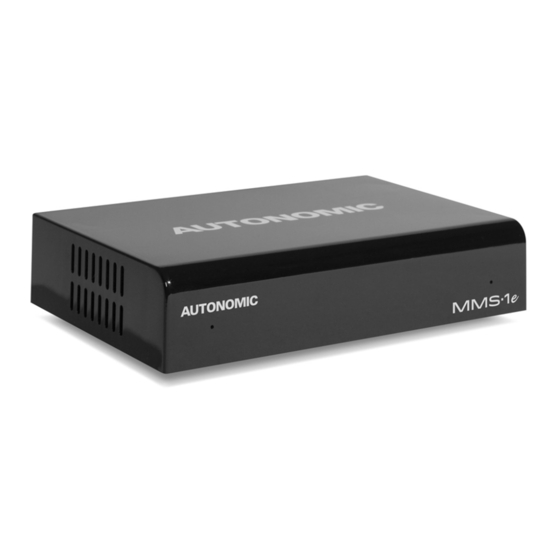Autonomic Mirage MMS-1e Руководство по настройке - Страница 9
Просмотреть онлайн или скачать pdf Руководство по настройке для Сервер Autonomic Mirage MMS-1e. Autonomic Mirage MMS-1e 18 страниц.

Fixed vs. Variable Gain
Fixed Gain is recommended when the connected amplifier has an accessible volume control.
NOTE
Failing to set the output to fixed in this circumstance can cause contention between the MMS
volume control and the amplifiers volume control and can affect sound quality.
Variable gain should be used if the MMS is connected to an amplifier that does not have a
volume control, or if you wish to control the volume of the MMS directly with the Mirage web
interface or mobile applications.
Disabling Unused Outputs
If you will not be using all of the available outputs, set the option to
those outputs from consuming system and power resources, and will remove these items from
appearing in lists.
Renaming Outputs
You can rename source outputs by clicking on their name in the web browser. The new name
will be used on our web control interface and mobile applications.
For control system integrations, the server will respond to commands issued using the default
output names, as well as commands issued using the new names. For this reason, you should
avoid renaming the outputs to any of the other default names (ie, Main, Player_A, etc.)
Bit Depth And Sample Rate Resolution
You can set the bit depth and sample rate of the digital audio outputs to values from 16-bit/44
kHz, up to 24-bit/96kHz on the MMS-1e.
You should set this value to the highest setting that your amplifier or AV receiver can support. If
you're unsure of the highest supported bit depth and sample rate on your equipment, the MMS
will play a sample sound in each speaker whenever you change this setting. If you hear the test
tone, your amplifier supports that setting. If you do not hear a test tone, lower this setting until
you can hear the test signal.
Using AirPlay
The
section allows you to assign all outputs on the MMS to be Airplay
AirPlay Receiver
receivers. When enabled, the Mirage Media Server will be displayed on the AirPlay menu of any
device or software that supports AirPlay (iOS devices and iTunes running on a Mac or PC).
NOTE
In a Mirage Audio System configuration, Airplay will be displayed on the AirPlay menu of any
device or software that supports AirPlay (iOS devices and iTunes running on a Mac or PC) as
zone names.
When the Mirage Media Server is selected, any currently playing content will be interrupted
and the server will begin to wirelessly stream the content from the connected device.
This can be overridden by selecting any other content for playback through the Mirage web
interface, mobile applications, or IP control.
The optional AirPlay password allows you to set a
(or iTunes) will be prompted for before the MMS will accept a stream from the device. This will
prevent uninvited transmissions from being broadcast to your amplifier.
Mirage Media Server Set Up
Disabled
. This will keep
that the user of the mobile device
password
8 of 15
